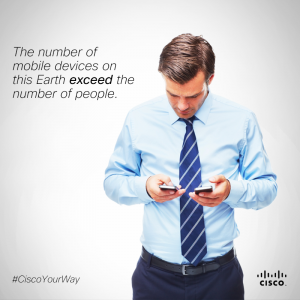 By the end of this year, the number of mobile-connected devices will exceed the number of people on earth. As mobile device exponentially grows around the globe, the Internet of Everything (IoE) is driving even more relevant connections – reaching people and processes in new and unique ways.
By the end of this year, the number of mobile-connected devices will exceed the number of people on earth. As mobile device exponentially grows around the globe, the Internet of Everything (IoE) is driving even more relevant connections – reaching people and processes in new and unique ways.
Service providers are seeking new ways to accommodate the surge in mobile data traffic, smart portable devices and things coming onto their networks. As mobile devices proliferate, so do the opportunities to strengthen relationships with customers by delivering a superior subscriber experience.
Based on predictions in Cisco’s latest VNI Global Mobile Data Traffic Forecast, we know that we are just scratching at the surface of what’s possible in terms of creating new mobile customer experiences and revenue. Take a look at a few key growth predictions for next five years:
- By the end of 2013, the number of mobile-connected devices will exceed the number of people on earth, and by 2017 there will be nearly 1.4 mobile devices per capita
- Mobile network connection speeds will increase 7-fold
- Two-thirds of the world’s mobile data traffic will be video
Based on these predictions and the explosion of mobile data traffic traversing networks, service providers need to pay attention to mobility. The question is no longer “Can service providers make money from Wi-Fi?” Rather, it is “Where should they focus their efforts, and when should they deploy?”
It’s clear that the future of monetizing mobile networks will depend on how well service providers respond to the increasing demand for pervasive video and faster speeds by leveraging a network built with mobility in mind.
Everywhere, Anytime Video
The explosion of mobile video is opening the door wide open for service providers to provide new dynamic and real-time opportunities for their customers. Video is not only compelling, research shows it urges viewers to act. According to Invodo, 92 percent of mobile video viewers share videos with others. In addition, Cisco VNI reveals that iOS and Android users consumed over 800MB per month of data under tiered pricing in the last quarter of 2012, with the lion’s share of data, 45% for smartphone and 50% for Tablet, went towards going toward video viewing.
With this increase in more engaged viewers means more data to analyze and create insights vis-à-vis subscriber viewing behavior. A secure network that can support personalized and sharable video, will enable service providers to provide retailers, hoteliers and others unique opportunities to maximize their reach and better link advertisements with direct sales by tailoring content, tweaking pricing and more.
In addition, service providers can promote a “your way” experience across wired, Wi-Fi, and cellular networks, without compromising the network. The Intelligent Network provides granular, real-time visibility and updates across every level of the network-transport and user, access, core, and cloud. It’s an essential component for unleashing the power of everywhere, anytime video functionalities.
Faster Mobile Network and Device Processing Speeds
Another factor that is certain to fuel the monetization of networks is the speed at which our mobile devices are able to connect to the Internet or network and transfer data between devices. Our recent research explains that globally, the average mobile network connection speed in 2012 was 526 kbps. It is expected that by 2017 the average speed will exceed 3.9 Mbps, growing at a compound annual growth rate of 49 percent each year. While this is quite impressive, network speed will not be the only thing drastically increases into 2017. Smartphone speeds are forecasted to triple, reaching speeds of 6.5 Mbps.
With faster network and processing speeds, service providers can use Data in Motion to address primary objectives of monetization and optimization while providing exceptional user experiences. Data inMotion refers to real-time and near-real-time information that can enable contextual and personalized experiences or services with higher value (price, bit). Data points such as past Internet activity, app usage data, location and more can be joined with subscriber and network level policies and analytics in real or near-real time through a highly programmable network. Once this context is established, monetization opportunities such as targeted advertising fit in very organically. For example, applications such as online gaming (that needs higher download speeds) can be monetized by a service provider that offers bandwidth boost services like Turbo Boost.
This is real-time or near-real time context and activity is what underpins Data in Motion and is something that can differentiate a mobile operator in the crowded Big Data space. This intelligence can be extracted at multiple layers and then combined or correlated, resulting in access to valuable information for business-to-business and business-to-consumer services.
How will the future of mobile network monetization impact your business? For more information, check out Cisco’s recent white paper: “Wi-Fi: New Business Models Create Real Value for Service Providers.”
Follow @CiscoSP360 and join the conversation, #CiscoYourWay.

CONNECT WITH US